 Photo ©
Keith Williams
Photo ©
Keith Williams
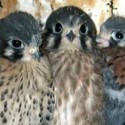
Growing Up Kestrel
Those who monitor American Kestrel nests know that these petite raptors are feisty and adaptable. But do the young kestrels that grow into handsome little falcons in your nest boxes ever return as adults? Or, do they strike out for parts unknown in some distant corner of the continent? The answers, from a new study in Idaho, may surprise you.
Since most kestrels breed in their first year after hatching, researchers did not have to wait long to see whether the kestrels were leaving home. Perhaps surprisingly, only 4% of the banded nestlings returned to nest in the study area, while the majority dispersed out of the study area. Of those that stayed put, females moved farther than males, about 6 miles (9.8 km) compared to the males’ 3.3 miles (5.3 km). Researchers think that although males are certainly capable of long-distance moves (one kestrel is known to have dispersed more than 1,200 miles!), they typically do not move as far because they need to defend territories. Females, on the other hand, are free to wander and choose the best available mate. Interestingly, juveniles whose parents were raised in the area were three times more likely to stay in the same area than those whose parents were immigrants. Two “local” sons even came back a few years later to nest in the very boxes from which they fledged.
How do American Kestrels compare to American people when it comes to leaving home? According to a 2008 Pew Research Center survey, the percentage of Americans who resided in the same town in which they were born was 37%, compared with just 4% of the studied kestrels remaining in their area of origin. The popular idea that most kestrels stay in the same “hometown” in which they were raised is more likely a reflection of our own human dispersal patterns—people are almost an order of magnitude more likely to stay!
Deciding whether to move or stay always involves tradeoffs. Kestrels leave their hometowns for some of the same reasons people do: to seek out new opportunities, to learn what’s out there, and to start a family. However, those that stay do so for reasons that we can also relate to: the climate is favorable, they know the area, and it’s a good place to raise kids. If you don’t yet have a kestrel nesting box available in your area, why not provide one in case this beautiful little falcon finds its way to your hometown?
Reference: Steenhof, K., and J. A. Heath. 2013. Local recruitment and natal dispersal distances of American kestrels. The Condor 115(3):584-592.
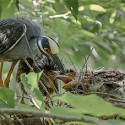
2013 NestWatch Pledge Drive
Simply put, the NestWatch program would not be possible without the generosity of people like you. Every year, thousands of individuals contribute their valuable time to help scientists better understand the nesting ecology of birds. NestWatchers have gathered information on more than 50,000 nesting attempts over the past 3 years alone! If you were unable to monitor any nests this year, you can still make a huge contribution to our ongoing study of nesting birds by supporting us with a small financial donation.
Because the Cornell Lab is a nonprofit organization, NestWatch is highly dependent on your generosity. We are half way to our goal of raising $4,000 by December 31 to print new NestWatch brochures and to help fund NestWatch seminars and workshops in 2014. More than 24,000 people receive this eNewsletter. If each of you contributes our suggested “nest egg” donation of just $10, we will be able to support much of our operational expenses for years to come. For donations of $25 or more, you will receive a beautiful NestWatch poster! Please consider making a contribution today. We sincerely appreciate your kindness! The future of NestWatch is in your hands.
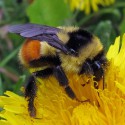
Bees Buzz, Birds Bail
In temperate forests, birds and bees both use tree cavities for their nesting activities. Because bumblebees prefer cavities filled with plant materials for insulation, they may benefit from stealing freshly built bird nests. A recent study from Seoul National University in South Korea showed that the buzz of a bumblebee in a nest might be one of the ways it scares off the birds.
The researchers observed that bumblebees were detected in up to 21% of freshly built nests of tits (relatives of our chickadees) and were not detected in nest boxes without any bird nests. Using miniature speakers and bumblebee mounts, researchers demonstrated that when birds heard the buzzing sound in their nest box, they became distressed and often left the nest. It is therefore possible that a bumblebee could use its buzz as a warning signal to oust birds from their newly-built nests.
Bees are important pollinators of the foods that birds and people need to survive, and they are also prey for birds, so sharing nests with them is not all bad. If you’d rather not have bees buzzing in your nest boxes, you can minimize the likelihood of bees colonizing your boxes by keeping them plugged until just before the breeding season of the target species. If bees have already moved into your box, consider leaving them “bee” and putting up an additional box for the birds. Like bird nests, bumblebee nests are temporary and can be cleaned out once the bees are finished. Don’t spray pesticides into a nest box, as the residue may remain even after cleaning and harm future nestlings.
There is so much to learn about the natural world, even about non-feathered friends, simply by observing birds’ nests! As a member of the world’s largest team of nest monitors, you can be a part of the buzz. Help us grow our hive of data by telling your friends about NestWatch.
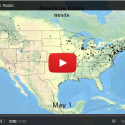
New Nesting Season Animations
Watch the progression of the nesting season like never before! We now have video animations that bring your data to life and illustrate patterns in nest locations. (Note that most nests from 2013 will not be included in these animations until a later date). Help us improve our understanding of the nesting timeline by contributing your observations today!
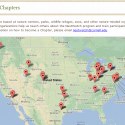
Welcome To Our Newest Chapter
We would like to welcome our newest NestWatch chapter, Northern Kentucky Bluebird Trail in Kenton County’s Parks, coordinated by Chrisula Stone. Welcome, Chrisula! To find a NestWatch chapter near you, visit our online chapters map.
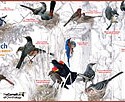
Monthly Winner
At the beginning of each month, NestWatch randomly selects one participant who has entered data that month to receive a copy of the NestWatch Common Nesting Birds of North America poster. This month’s lucky winner is Marianne Gooding. Congratulations, Marianne!